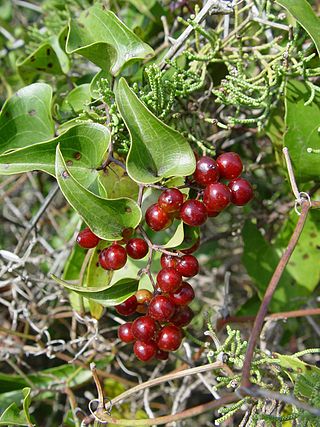
Smilax is a genus of about 300–350 species, found in the tropics and subtropics worldwide. They are climbing flowering plants, many of which are woody and/or thorny, in the monocotyledon family Smilacaceae, native throughout the tropical and subtropical regions of the world. Common names include catbriers, greenbriers, prickly-ivys and smilaxes. Sarsaparilla is a name used specifically for the Neotropical S. ornata as well as a catch-all term in particular for American species. Occasionally, the non-woody species such as the smooth herbaceous greenbrier are separated as genus Nemexia; they are commonly known by the rather ambiguous name carrion flowers.

Argyroxiphium sandwicense subsp. macrocephalum, the east Maui silversword or Haleakalā silversword, is a rare plant, part of the family Asteraceae. The silversword in general is referred to as ʻāhinahina in Hawaiian.

Polyscias racemosa, or false 'ohe, is a species of flowering plant in the family Araliaceae. As Munroidendron racemosum, the species was until recently considered to be the only species in the monotypic genus Munroidendron. With the change in classification, Munroidendron is now obsolete. Polyscias racemosa is endemic to the Hawaiian island of Kauai. It is very rare in the wild and some of its original habitat has been replaced by sugar cane plantations. It was thought for some time to be probably extinct, but was rediscovered a few years prior to 1967.
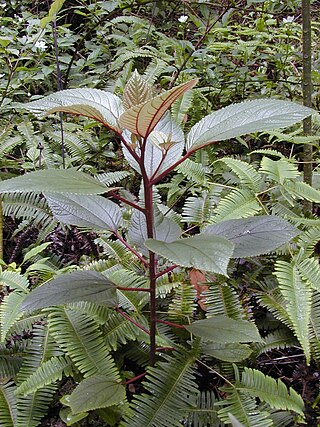
Pipturus albidus, known as māmaki in Hawaiian and known as Waimea pipturus in English, is a species of flowering plant in the nettle family, Urticaceae, that is endemic to Hawaiʻi. It inhabits coastal mesic, mixed mesic, and wet forests at elevations of 60–1,830 m (200–6,000 ft). Māmaki is a small tree that reaches a height of 9 m (30 ft) and a trunk diameter of 0.3 m (0.98 ft).

Sida fallax, known as yellow ilima or golden mallow, is a species of herbaceous flowering plant in the Hibiscus family, Malvaceae, indigenous to the Hawaiian Archipelago and other Pacific Islands. Plants may be erect or prostrate and are found in drier areas in sandy soils, often near the ocean. ʻIlima is the symbol of Laloimehani and is the flower for the islands of Oʻahu, Hawaiʻi, and Abemama, Kiribati.

Dubautia arborea, the tree dubautia or Mauna Kea dubautia, is a species of flowering plant in the family Asteraceae. A member of the silversword alliance, it is endemic to the island of Hawaiʻi. It is a shrub or small tree. It is an endangered species that is threatened by feral grazing animals.
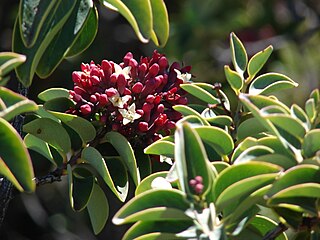
Santalum haleakalae, known as Haleakala sandalwood or ʻIliahi in Hawaiian, is a species of flowering tree in the sandalwood family, that is endemic to the islands of Maui, Lanai, and Molokai in the Hawaiian Islands, part of the United States. It grows in subalpine shrublands at elevations of 1,900 to 2,700 m, especially on the slopes of Haleakalā.

Korthalsella is a genus of flowering plants in the sandalwood family, Santalaceae. It contains about 25 species distributed in Asia, Africa, Australia, New Zealand, and some Pacific Islands.
Phyllostegia hispida, the hispid phyllostegia, is an endangered species of flowering plant in the mint family, Lamiaceae. It is found only in wet forests at elevations of 2,300–4,200 feet (700–1,280 m) on the island of Molokaʻi in Hawaiʻi. This green vine's loosely spreading branches often form a large mass.

Nestegis sandwicensis, commonly known as Hawai'i olive or olopua, is a species of flowering tree in the olive family, Oleaceae, that is endemic to Hawaii. It is found on all major islands at elevations of 30–1,300 m (98–4,265 ft) in coastal mesic and mixed mesic forests, and, especially, dry forests. It usually reaches a height of 6 m (20 ft) with a trunk diameter of 0.2 m (0.66 ft), but may reach 20 m (66 ft) in height with a trunk diameter of 0.9 m (3.0 ft).

Smilax aspera, with common names common smilax, rough bindweed, sarsaparille, and Mediterranean smilax, is a species of flowering vine in the greenbriar family.

Smilax glauca, the cat greenbriar or catbriar is a woody vine in the family Smilacaceae. It is native to central and eastern portions of the United States as well as Mexico, where it is a common and conspicuous part of the forest vegetation.

Rumex skottsbergii, or more commonly known as lava dock, is a shrub of the genus Rumex. The genus comprises approximately 200 species all derived from a single species and are therefore monophyletic. Furthermore, Rumex skottsbergii is endemic to Hawaii, where it is known as pāwale. Pāwale are commonly found in open lava fields that are at low elevations which range from 460-1300m. A similar plant in this genus is Rumex giganteus. Their similarity lies between their erect nature and leaves. However, the difference lies in their inflorescences. The inflorescences is described as being a cluster of flowers from the main stem axis.

Smilax china is a climbing plant species in the genus Smilax. It is native to China, Korea, Taiwan, Japan, Philippines, Vietnam, Thailand, Myanmar, and India. It also known as china root, china-root, or chinaroot, as is the related Smilax glabra.

Kokia, with the common name treecotton, is a genus of flowering plants in the mallow family, Malvaceae.
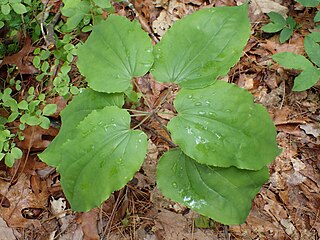
Smilax biltmoreana, common name Biltmore's carrionflower, is a North American plant species native to the south-eastern United States. It is concentrated in the Great Smoky Mountains but with outlying populations in Virginia, North and South Carolina, Tennessee, Kentucky, Georgia, Alabama, and northern Florida.

Smilax lasioneura, the Blue Ridge carrionflower, is a North American species of flowering plants in the greenbriar family. It is widespread across central Canada and the central United States, from Ontario, Manitoba and Saskatchewan south to Texas, Louisiana, and Florida.
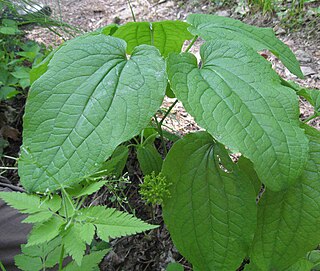
Smilax ecirrhata, the upright carrionflower, is a species of flowering plant in the Greenbriar family. It is native to Ontario and to the central United States. It is found in rich, calcareous forests along floodplains. It is an herbaceous plant that has green umbels of flowers in late spring.
Warren Lambert Wagner is an American botanist, a curator of botany, and a leading expert on Onagraceae and plants of the Pacific Islands, especially plants of the Hawaiian Islands.

Viola maviensis, commonly known as the Hawai'i bog violet, a species of woody-stemmed violet endemic to Hawaii, United States.

















